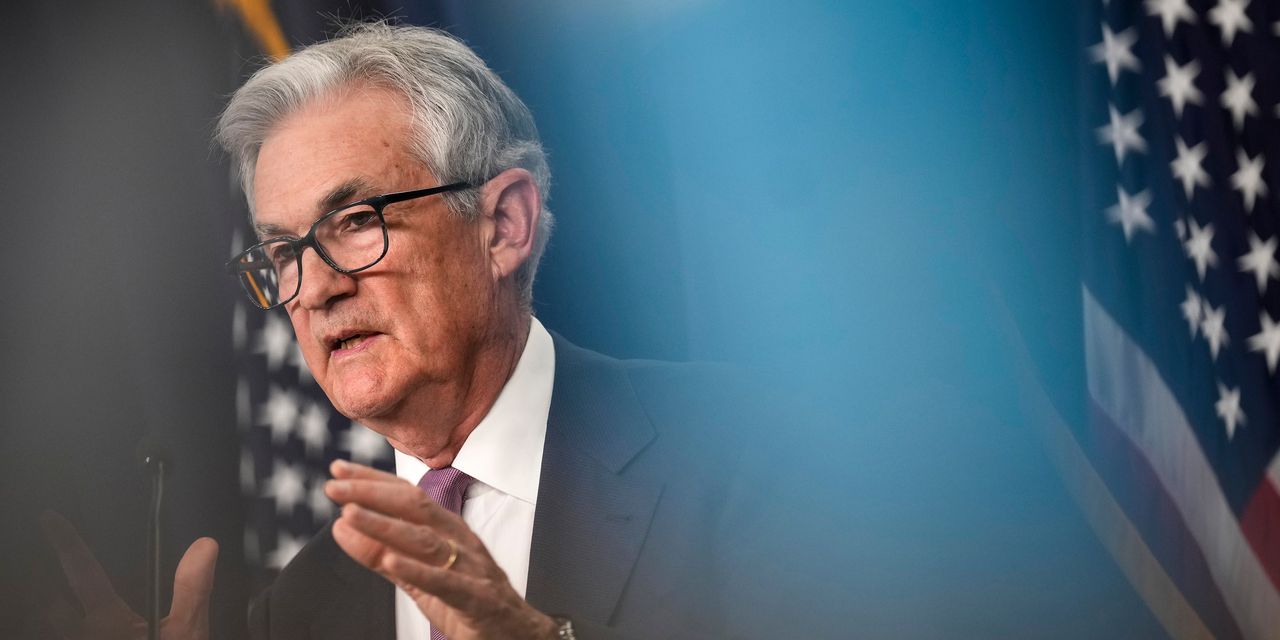Why would the Federal Reserve let up on the monetary brakes but at the same time promise to step down harder later on? Economics and politics might have figured into the puzzling policy decision.
In case you missed it, the Federal Open Market Committee voted this past week to hold its federal-funds target range at 5% to 5.25%, after having raised the key policy rate 10 times, by a total of five full percentage points, over the past year and a quarter. The pause was widely expected after having been telegraphed by Fed governor Philip Jefferson, who has been nominated as the central bank’s vice chair.
But the FOMC also lifted its year-end projected fed-funds rate to a median of 5.6%, a half-point higher than in its previous Summary of Economic Projections, issued after its March 21-22 meeting. Moreover, none of the 18 panel members projected any interest-rate cuts later this year, contrary to market expectations of just a month ago for reductions of a half-percentage point or more by the mid-December confab.
Various Fed officials will hold forth on their outlook for the economy and monetary policy in the days ahead, including Chairman Jerome Powell, who is slated to make his semiannual appearance before Congress, starting with the House Financial Services Committee on Wednesday.
In the meantime, let’s look at the dueling aspects of the FOMC’s action. There were no dissents at this past week’s meeting, continuing the recent conformity at the central bank.
All voters were thus in agreement with the committee’s rationale, which stated, “Holding the target range steady at this meeting allows the committee to assess additional information and its implications for monetary policy.”
That would include the employment and consumer-price-index reports for June, which will be released ahead of the July 25-26 FOMC meeting. The Fed officials also should have more information about any aftereffects on credit availability from the recent failures of Silicon Valley Bank and others.
Not mentioned in the FOMC statement was the impact of the suspension of the federal debt ceiling and the sharply stepped-up Treasury borrowing to refill the government’s coffers. That process removes liquidity from the financial system, which some estimate could be equivalent to a quarter-point hike in the fed-funds rate.
At his postmeeting news conference, Powell responded to a question about this, saying, “We’ll be monitoring market conditions carefully as the Treasury refills the [Treasury General Account].”
By not hiking rates now, the Fed may be buying time to minimize the impact of the Treasury’s borrowing (totaling nearly $300 billion this past week alone), according to the Strategas policy team led by Dan Clifton.
Last Thursday’s auction of four-week T-bills brought an investment rate of 5.113%, a hefty price for Uncle Sam and stiff competition for banks, notably small and medium-size institutions, especially considering Treasuries’ exemption from state and local income taxes. By holding off on another quarter-point rate hike, to 5.25%-5.50%, until the July 26 meeting (a 74% probability as of Friday, according to the CME FedWatch site), the Fed effectively provided the Treasury and the banks with a bit of extra breathing room.
At the same time, the FOMC lifted its median year-end fed-funds projection to 5.6%, as noted above, implying two more quarter-point hikes. This increase reflected revised economic projections. In particular, the Fed’s year-end estimate of its main inflation gauge—the core personal consumption expenditure, or PCE, deflator, which excludes food and energy prices—was upped to 3.9% from 3.6% in its March Summary of Economic Projections. The unemployment rate now is seen at 4.1% at year end, versus the previous 4.5% projection and above the May jobless rate of 3.7%.
Deutsche Bank’s economists wrote in a client note that Powell sounded pessimistic on the progress in curbing inflation. As I noted in my Up & Down Wall Street column last week, core PCE increased at a 4.3% rate in the most recent three months through April, only slightly less than the 4.7% rate in the past 12 months. That is more than double the Fed’s 2% target.
To get to 2%, the Fed is aiming for a level of interest rates that it deems to be “sufficiently restrictive.” Powell said last November that would mean Treasury yields significantly above the inflation rate for all maturities, Jim Bianco, the eponym of Bianco Research, reminded clients in a conference call this past week. That would put the benchmark 10-year note yield at 5.25%, far above Friday’s 3.76% level, he added.
Bianco’s takeaway is that inflation is causing a decline in all Americans’ real purchasing power, which means that Powell & Co. will emphasize getting inflation down, even if it means a higher jobless rate.
Beyond economics, that could be a good political strategy. By restraining inflation with more rate hikes this year, the Fed has scope to lower them during the 2024 election campaign. Call me cynical, but it’s naive to ignore politics with any Washington institution, including the Fed.
Write to Randall W. Forsyth at [email protected]
Read the full article here













